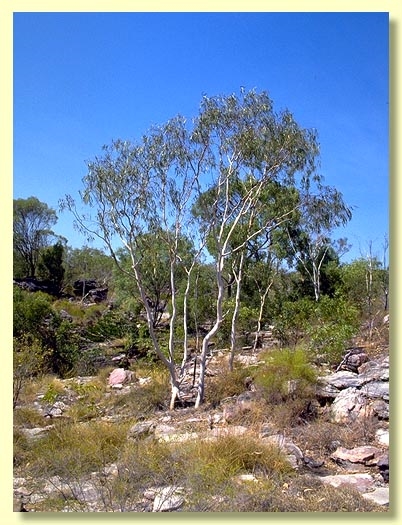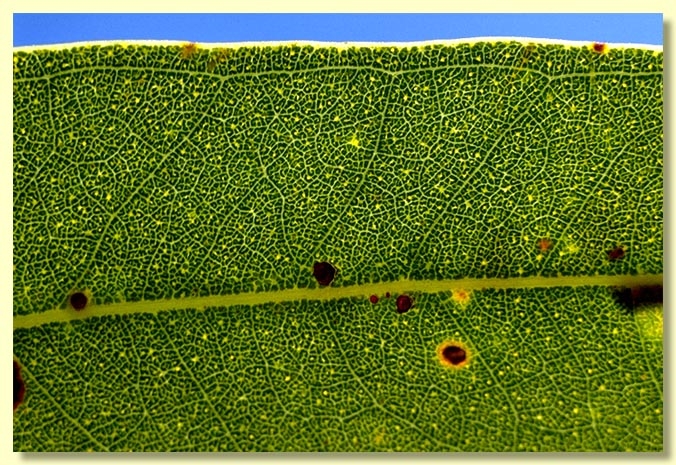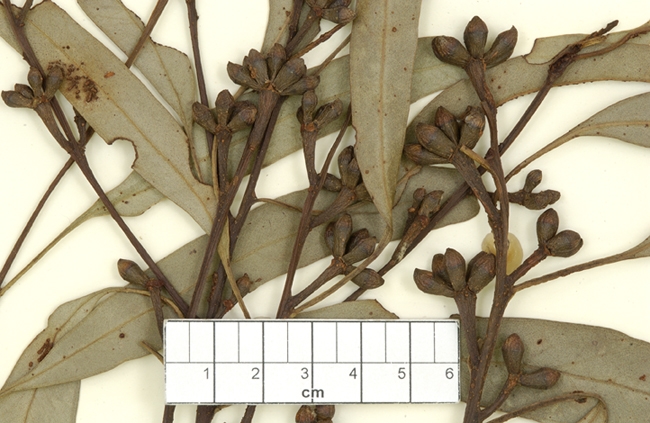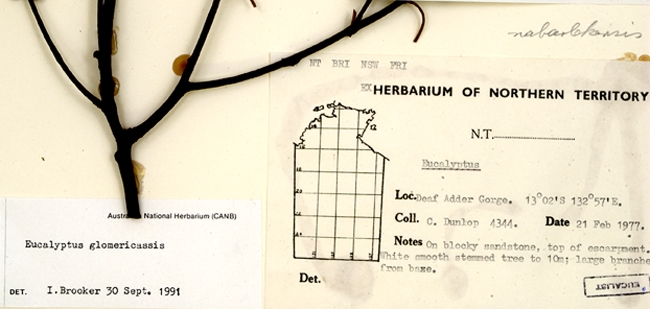Euclid - Online edition
Eucalyptus glomericassis
Eucalyptus | Symphyomyrtus | Exsertaria | Subexsertae | Pyramidales
Eucalyptus glomericassis L.A.S.Johnson & K.D.Hill, Telopea 8 (4) 516 (2000).
T: Northern Territory: Deaf Adder Gorge, 13° 02’ S 132° 57’ E, C.Dunlop 4344, 21 Feb 1977; holo: NSW; iso: CANB, DNA.
Tree to c. 10 m tall. Forming a lignotuber.
Bark smooth throughout, new bark pale pink to pale orange, maturing to white and then grey.
Juvenile growth (coppice or field seedlings to 50 cm): not seen
Adult leaves alternate, petiole 1–3 cm; blade narrowly lanceolate to lanceolate, sometimes falcate, (10)12–25 cm long, 1–2(3) cm wide, base tapering to the petiole, margin entire, apex pointed, concolorous, glossy green, side-veins acute or at a wider angle than 45° to the midrib, reticulation dense to very dense, intramarginal vein present, oil glands small, island and intersectional.
Inflorescence axillary unbranched, peduncles 0.8–1.6 cm long, buds 7 per umbel, pedicellate or sometimes shortly pedicellate (pedicels 0.2–0.3 cm long). Mature buds obovoid, 0.7–0.9 cm long, 0.5–0.6 cm wide, not glaucous, scar present, operculum ± conical to rounded, sometimes shortly apiculate (operculum 0.4–0.5 cm long), hypanthium sometimes 2 or 3-ridged, stamens irregularly flexed or with some outer stamens erect and the inner ones inflexed, anthers oblong, versatile, dorsifixed, dehiscing by longitudinal slits, style long and straight, stigma blunt, locules usually 4, the placentae each with 4 to 6 vertical rows of ovules. Flowers white.
Fruit pedicellate (pedicels 0–0.4 cm long), sometimes shortly pedicellate to rarely sessile, obconical to rarely cup-shaped, 0.4–0.6 cm long, 0.6–0.9 cm wide, disc raised to ± level, convex to annular, valves 4, strongly exserted.
Seeds dark brown, 1–1.5 mm long, ± obliquely pyramidal to cuboid to sometimes linear, dorsal surface shallowly reticulate, ventral surface ribbed, edge of seed sharply toothed, hilum terminal.
Cultivated seedlings (measured at ca node 10): cotyledons shallowly bilobed, stem square in cross-section, not glaucous; leaves opposite for ca 8, then alternate, always petiolate, ovate, 5–8 cm long, 2–5.5 cm wide, base rounded to tapering to the petiole, green.
Flowering has been recorded in January.
A small tree confined to the sandstone escarpments of the Kakadu National Park and the western end of the Arnhem Land plateau. Characterised by the smooth white bark, the distinctly petiolate, concolorous, narrowly lanceolate, glossy green adult leaves, the relatively large buds and fruit, the fruit with a relatively broad annular disc and prominently exserted valves.
Eucalyptus glomericassis belongs to a small group of species closely related to the red gums. This group is distinguished by having smooth powdery bark, adult leaves with dense to very dense reticulation and intersectional or absent oil glands, buds with incurved or erect stamens, fruit with an annular disc and obliquely pyramidal, toothed seeds with a ± terminal hilum. Other members of this group are E. mooreana, E. herbertiana, E. cupularis, E. pantoleuca and E. gregoriensis.
Within this group, E. glomericassis is closest to E. herbertiana, E. cupularis and E. gregoriensis. It differs by having glossy adult leaves and fruit with a broad disc (E. herbertiana, E. cupularis and E. gregoriensis all with dull adult leaves and a relatively narrow disc on the fruit). E. herbertiana and E. gregoriensis can be further distinguished by having smaller fruit (E. herbertiana and E. gregoriensis with fruit 0.6 cm or slightly narrower while E. glomericassis with fruit 0.6 cm or wider). Further more, E. gregoriensis usually has three-budded umbels while E. glomericassis is seven-budded. It is easily distinguished from the other two members of the group, i.e. E. mooreana and E. pantoleuca, by its adult leaf shape and position. E. glomericassis has petiolate, narrowly lanceolate, alternate, glossy green adult leaves, while E. mooreana has sessile, opposite, elliptical to ovate, dull blue-grey to glaucous adult leaves and E. pantoleuca has petiolate, ± opposite, orbicular to deltoid, dull glaucous adult leaves.
Within its area of occurrence, E. umbrawarrensis is the only other closely related white gum superficially similar to E. glomericassis. Both have relatively long, narrow lanceolate, glossy green adult leaves. However, both can be easily separated by their fruit dimensions. E. glomericassis has obconical to cup-shaped fruit, 0.6 cm or wider while E. umbrawarrensis has hemispherical to cup-shaped fruit 0.4 cm or slightly narrower.
Eucalyptus glomericassis: Latin glomus, a ball, cassis, a helmet, referring to the shape of the operculum.
















